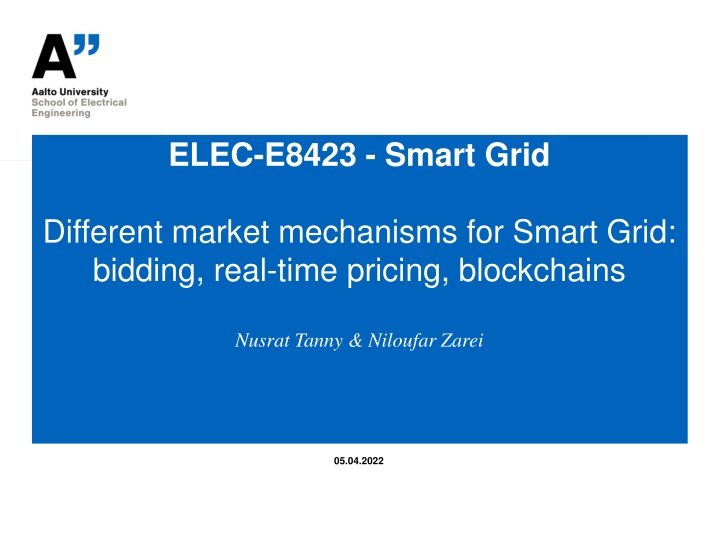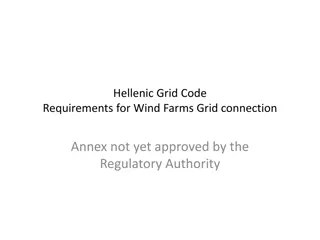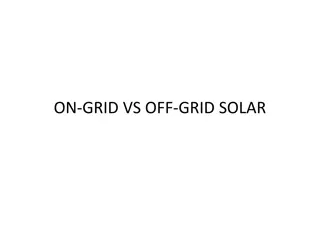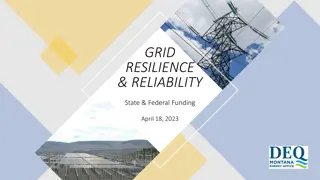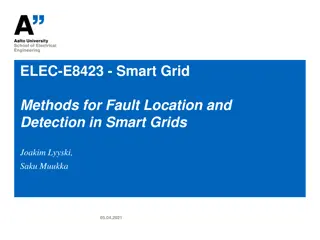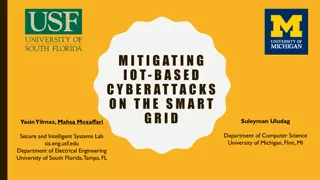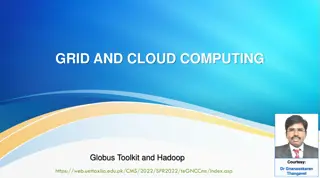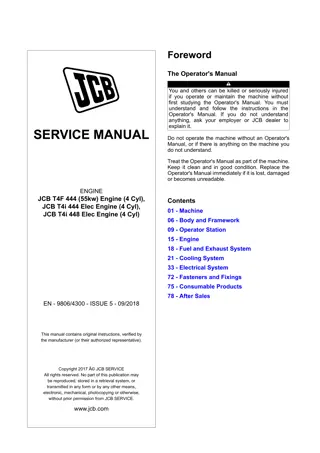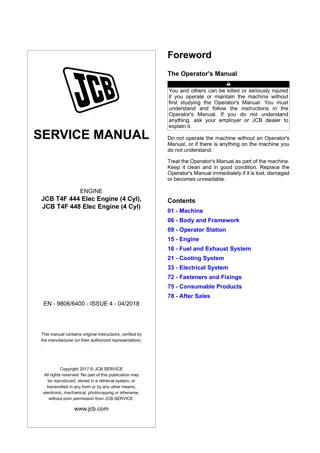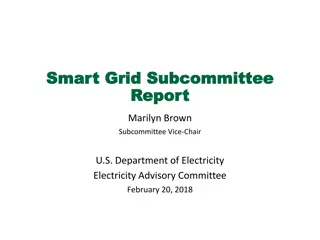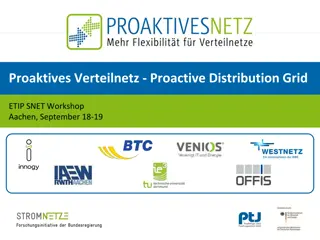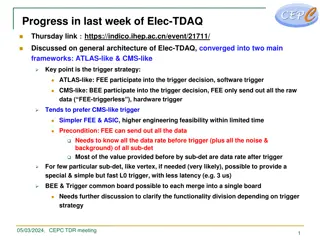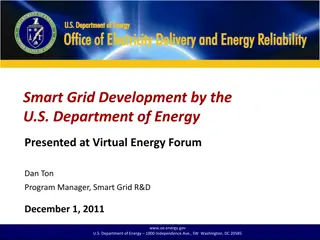ELEC-E8423 - Smart Grid
Smart Grid presents new opportunities for integrating green technologies through innovative market mechanisms like bidding, real-time pricing, and blockchains. Demand response plays a crucial role in balancing supply and demand efficiently. Explore the roles of demand response in the electricity system, including price-based strategies and economic scheduling. Dive into demand bidding programs and real-time pricing schemes, understanding their benefits and challenges in shaping the future electricity market landscape.
Download Presentation

Please find below an Image/Link to download the presentation.
The content on the website is provided AS IS for your information and personal use only. It may not be sold, licensed, or shared on other websites without obtaining consent from the author.If you encounter any issues during the download, it is possible that the publisher has removed the file from their server.
You are allowed to download the files provided on this website for personal or commercial use, subject to the condition that they are used lawfully. All files are the property of their respective owners.
The content on the website is provided AS IS for your information and personal use only. It may not be sold, licensed, or shared on other websites without obtaining consent from the author.
E N D
Presentation Transcript
ELEC-E8423 - Smart Grid Different market mechanisms for Smart Grid: bidding, real-time pricing, blockchains Nusrat Tanny & Niloufar Zarei 05.04.2022
Introduction Smart Grid new vision to figure out an efficient way of integrating green & renewable technologies. Also called "Energy internet". Demand response (DR) has an important role in the future of the electricity market for maintaining the balance between supply and demand by introducing load flexibility Blockchain Distributed DR based on control mechanism Centralized Demand Response Incentive- based Demand bidding DR based on offered motivations DR based on decision variable Price- based DR Realtime price 05.04.2022 07.02.2018 Page 2
Roles of demand response in the electricity system by timescale Price-based demand response Day-ahead hourly pricing(RTP) Real-time hourly pricing (RTP) Time-of-use pricing Step 2 Day-ahead Economic scheduling Day-of Economic dispatch Months Operational planning Load Demand response release Years Less than 15 curtailment timescales System planning Demand bidding / buyback Interrup tible progra ms Emerg ency progra m Ancillary service Direct load control Incentive-based demand response Step 1 05.04.2022 07.02.2018 Page 3
Demand Bidding Demand Bidding (also called Buyback) is a program in which consumers bid on specific load reductions in the electricity wholesale market. A bid is accepted if it is less than the market price. When a bid is accepted, the customer must curtail his load by the amount specified in the bid or face penalties. is useful for both the consumers and system operator (SO) improves market efficiency by providing the opportunity for consumers to change the market clearing price (MCP) in peak hours Challenges- - Privacy is the key issue. - takes time to recruit customers for a demand response program 05.04.2022 07.02.2018 Page 4
Realtime Pricing Real time Pricing (RTP) is a dynamic pricing scheme, with the price updating cycle of 1 hour or less RTP customers are informed about the prices on a day-ahead (Day-ahead Real-Time Pricing (DA-RTP) or hour-ahead wholesale prices (to ensure that customers have sufficient time to respond to RTP) RTP is the most direct and efficient demand response program suitable for the future electricity market RTP brings some advantages for customers, such as increasing their awareness regarding consumption and subsequently decreasing their consumption, especially during the high electricity price Reaching to reach RTP in the electricity market brings some challenges. 05.04.2022 07.02.2018 Page 5
Realtime Pricing (Challenges) The major challenge faced in the implementation of "real time " is that both the data collection and the decision making must be completed within a minimal time Due to the minimum time for notification in advance, there is a need for the development of a methodology which is advanced and capable of finding an optimal solution as fast as possible Hence the computational methodology involves high level of complexity Because of the computational complexity involved, the methodology must be properly tested during the developmental stages The development of energy management system can ensure the collection of online data and assist in the decision-making process The demand management from load or consumer side is expensive and ineffective due to high transaction costs 05.04.2022 07.02.2018 Page 6
Blockchain for Smart Grid1 - Blockchain as a decentralized and distributed technology provides promising applications in the smart grid infrastructure with its excellent and salient features. The concept of blockchain is to decentralize power to build trust between untrusted parties. A blockchain consists of blocks with a growing list of records that are linked using cryptography to resist the alteration of the data. The main advantage of this technology is that it maintains all the variations in the blocks as all blocks are connected in the chain and no block can be modified or removed. 05.04.2022 07.02.2018 Page 7
Blockchain for Smart grid2 -main area of application Opportunities Moving towards Decentralized Smart Grid System Use of Blockchain to Monitor, Measure, and Control has a great impact on energy trading for eradicating false transaction scalable in nature provides a resilient and better fault-tolerant network in which an error or malicious attack can be identified and removed easily. Challenges Security and privacy Standardization Immature technology Future direction- Blockchain interoperability 05.04.2022 Page 8 07.02.2018
Conclusions Demand Bidding gives the opportunity for consumers to change the market clearing price and it helps to improve market efficiency but still there has some privacy issue RTP could serve to improve market efficiency, mitigate market power, dampen wholesale price volatility, and bolster system reliability but more advanced metering systems are needed RTP would not be expected to deliver short-term results with regard to equipment purchases. But in long term, the cost of electricity saved exceeds the incremental cost of the equipment purchased Considering security, privacy and trust issue "Blockchain Technology" has attracted the rapid growing attention in smart grid area. the smart meters or electrical vehicles as well as other parts of the smart grid need a reliable and efficient communication infrastructure. Deploying appropriate technology in smart grid communication infrastructure is an open problem. There are some challenges in deploying each one of the technologies, e.g., security, performance, and privacy. 05.04.2022 07.02.2018 Page 9
List of References [1] Daiva Stanelyte, N. R. (2022). Overview of demand-response services: A review. Retrieved from Energies: https://www.mdpi.com/1996-1073/15/5/1659/htm [2] Demand Bidding. (2019). content/uploads/2019/11/3.Task_8_Demand_Side_Bidding_Brochure.pdf [3] JeffZethmayr, D. ( March, 2018). The costs and benefits of real-time pricing: An empirical investigation into consumer bills using hourly energy data and prices, 50-57. [4] koliou, E. (2016). DEMAND RESPONSE POLICIES FOR THE IMPLEMENTATION OF SMART GRIDS. Retrieved https://repositorio.comillas.edu/xmlui/bitstream/handle/11531/7166/TD00195.pdf?isAllowed=y&sequence=1 [5] Li, W.-T., Yuen, C., Hassan, N. U., Tushar, W., Wen, C.-K., Wood, K. L., . . . Liu, X. (n.d.). Demand Response Management for Residential Smart Grid: From Theory to Practice. 2431 - 2440. Retrieved from https://ieeexplore.ieee.org/abstract/document/7336481/authors#authors [6] M.H.Albadi, E.-S. ( November, 2008). A summary of demand response in electricity markets, 1989-1996. [7] Muhammad Baqer Mollah, J. Z. (2020). Blockchain for Future Smart Grid: A Comprehensive Survey. [8] N. Arjomand, H. S. (n.d.). A Review of Blockchain-based Smart Grid: Applications, Opportunities, and Future Directions. [9] Vardakas, J. S., Zorba, N., & Verikoukis, C. V. (2015). A Survey on Demand Response Programs in Smart Grids: Pricing Methods and Optimization Algorithms, 152-178. [10] Arun Sekar Rajasekaran a, *. M.-T. (2022). A comprehensive survey on blockchain technology. Retrieved from https://userstcp.org/wp- from 05.04.2022 Page 10 07.02.2018
Thank you ! 07.02.2018
